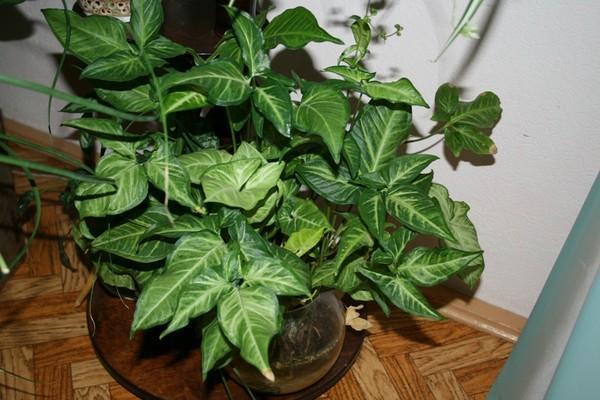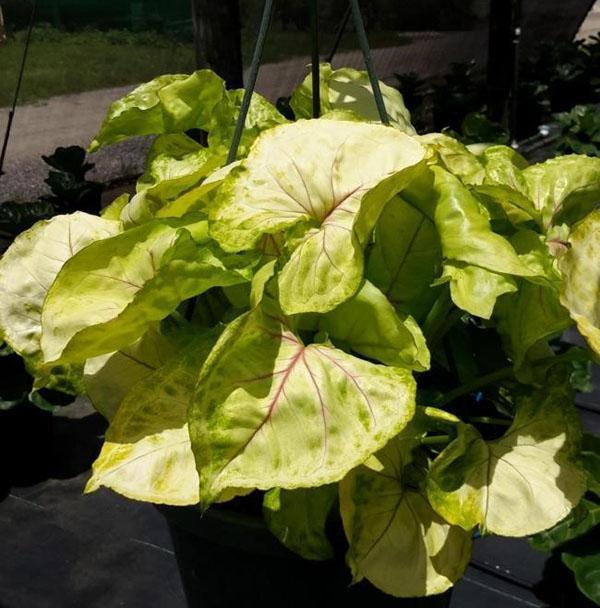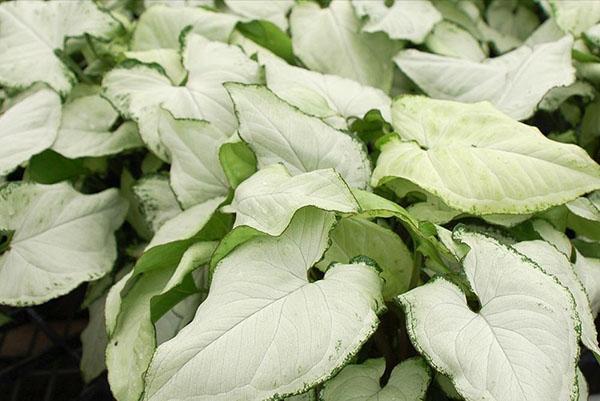Types of syngonium for home cultivation
 In nature, there are several dozen varieties of syngonium inhabiting humid tropical areas. Views syngonium for home cultivation are not so numerous. 5-6 varieties are cultivated all over the world, and an incredible variety of shapes and colors is created through the development of new varieties and hybrids.
In nature, there are several dozen varieties of syngonium inhabiting humid tropical areas. Views syngonium for home cultivation are not so numerous. 5-6 varieties are cultivated all over the world, and an incredible variety of shapes and colors is created through the development of new varieties and hybrids.
Syngonium podophyllum

 In nature, vines with a thin stem, often forming lateral shoots, are well recognized by their green arrow-shaped foliage. Leaves with a pronounced central vein are held on elongated dense petioles. As the plant grows up and its development of the upper tiers of the forest, the leaves acquire a complexly divided shape and resemble a three- or five-toed paw.
In nature, vines with a thin stem, often forming lateral shoots, are well recognized by their green arrow-shaped foliage. Leaves with a pronounced central vein are held on elongated dense petioles. As the plant grows up and its development of the upper tiers of the forest, the leaves acquire a complexly divided shape and resemble a three- or five-toed paw.
 Although the natural form of the leg-leaved syngonium is not too decorative, it was she who became the basis for breeding work and gave the world community of flower growers numerous varieties of this indoor plant.
Although the natural form of the leg-leaved syngonium is not too decorative, it was she who became the basis for breeding work and gave the world community of flower growers numerous varieties of this indoor plant.
 In addition to bright varieties with leaves of spotted, almost completely white, pink and purple color, the line of artificially bred Pixie cultivars is available to flower growers. This is a dwarf species of syngonium for growing at home. In the first year of life, the plants form lush rosettes of pointed leaves of different colors, and then the formation of climbing stems begins.
In addition to bright varieties with leaves of spotted, almost completely white, pink and purple color, the line of artificially bred Pixie cultivars is available to flower growers. This is a dwarf species of syngonium for growing at home. In the first year of life, the plants form lush rosettes of pointed leaves of different colors, and then the formation of climbing stems begins.
Unfortunately, the dwarfism of the syngonium is achieved with the help of growth inhibitors, therefore, over time, such specimens or their offspring regain their size given by nature.
 Among the species of syngonium bred for home cultivation in recent years, there are varieties not only with two-, but also with tricolor leaves. Moreover, more spectacular than their wild ancestors, plants are just as unpretentious and hardy.
Among the species of syngonium bred for home cultivation in recent years, there are varieties not only with two-, but also with tricolor leaves. Moreover, more spectacular than their wild ancestors, plants are just as unpretentious and hardy.
 The leg-leaved syngonium, in suitable conditions, reaches a considerable height and annually gives good growth, which can be used for further vegetative propagation of a house flower. To get a new specimen, a small cutting with a bud and root primordia hidden to the leaf axil is enough.
The leg-leaved syngonium, in suitable conditions, reaches a considerable height and annually gives good growth, which can be used for further vegetative propagation of a house flower. To get a new specimen, a small cutting with a bud and root primordia hidden to the leaf axil is enough.
For full growth, the flower needs support. Already from the age of two, and sometimes even earlier, the plant takes the form of a climbing liana, which, if desired, can be easily formed.
Syngonium auritum (Syngonium auritum)
 The second most common in indoor collections after the described variety was the ear syngonium. It is a large climbing liana, with high growth rates, original-shaped leaves and rather thick sturdy stems. Under favorable conditions, the plant grows by 50–80 cm annually, requires strong support and is easily propagated by cuttings.
The second most common in indoor collections after the described variety was the ear syngonium. It is a large climbing liana, with high growth rates, original-shaped leaves and rather thick sturdy stems. Under favorable conditions, the plant grows by 50–80 cm annually, requires strong support and is easily propagated by cuttings.
A peculiarity of the culture is the leaves sitting on long cuttings reaching 30 cm, which become 3-5 lobed as they grow. At the base of the leaf blade, small, curved segments are preserved, resembling the ears of an animal.
Syngonium wendlandii
 In the lower and middle tier of the subtropical forests of Costa Rica, the Wendland or Wendland syngonium, named after the famous botanist and naturalist, lives.The pointed leaf plates are divided into three parts, and much less than the central one. The main vein of a dense, slightly velvety leaf is shaded with a white stroke.
In the lower and middle tier of the subtropical forests of Costa Rica, the Wendland or Wendland syngonium, named after the famous botanist and naturalist, lives.The pointed leaf plates are divided into three parts, and much less than the central one. The main vein of a dense, slightly velvety leaf is shaded with a white stroke.
Although in beauty and unpretentiousness this plant is not inferior to other types of syngonium for home cultivation, it is rarely found on window sills.
Large-leaved syngonium (Syngonium macrophyllum)
 Among the botanical rarities in indoor collections is the large-leaved syngonium, which grows wild in forests from Mexico to Ecuador. Externally, the plants resemble leg-leaved syngonium, but much more powerful, and their young castings have a pointed-heart-shaped shape.
Among the botanical rarities in indoor collections is the large-leaved syngonium, which grows wild in forests from Mexico to Ecuador. Externally, the plants resemble leg-leaved syngonium, but much more powerful, and their young castings have a pointed-heart-shaped shape.
 Under natural conditions, a large liana with the help of aerial roots perfectly masters the middle and upper tier of the tropical forest. In the house, this type of syngonium does not reach such sizes and shows itself as a picky, decorative leafy culture for spacious shaded rooms.
Under natural conditions, a large liana with the help of aerial roots perfectly masters the middle and upper tier of the tropical forest. In the house, this type of syngonium does not reach such sizes and shows itself as a picky, decorative leafy culture for spacious shaded rooms.
Syngonium narrowed (Syngonium angustatum)
 Unlike other types of syngonium for growing at home, the leaves of the narrowed syngonium can not be divided into 3-5 into a much larger number of segments. The South American liana perfectly adapts to life in a limited pot and can reach several meters in length under indoor conditions.
Unlike other types of syngonium for growing at home, the leaves of the narrowed syngonium can not be divided into 3-5 into a much larger number of segments. The South American liana perfectly adapts to life in a limited pot and can reach several meters in length under indoor conditions.
Interesting about syngonium
 Syngonium is a common indoor plant that has earned not only the approval of the growers themselves, but also of feng shui specialists. They see in the 5-lobed leaves a sign of the unity of the five basic elements.
Syngonium is a common indoor plant that has earned not only the approval of the growers themselves, but also of feng shui specialists. They see in the 5-lobed leaves a sign of the unity of the five basic elements.
Water, fire, earth, wood and metal come together to create the perfect balance of Yin-Yang and give their strength and energy boost to humans.
If, according to these ideas, put a pot of syngonium on a bureau or table, the person working at it will feel a surge of inspiration, new ideas will come to him, freshness of perception and a cheerful cheerful mood will appear.
Interestingly, the syngonium is being studied very closely by NASA specialists engaged in environmental problems and the search for air purifier plants. The selection of such cultures will help in the future during interplanetary flights, will give astronauts full autonomy and the ability not to depend on the earth's air reserves.
While distant space travel is still far away, flower owners can use all types of syngonium for home cultivation as a kind of green filters. Plants actively collect many volatile organic compounds such as benzene, formaldehyde, toluene, and xylene. They reduce the concentration of microbes in the air and help maintain optimal humidity.